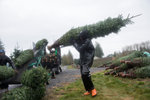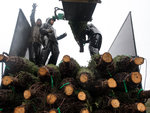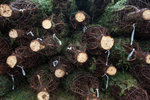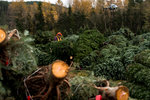



While most people were thinking of Halloween costumes, Christmas tree farmers of Lewis County were thinking about supplying customers in Hong Kong and the thousands of trees they’ll cut down in the weeks leading up to Christmas.
On a drizzling Friday morning in October, John Burton walked through rows of trees, stopping only to occasionally measure and select those that caught his eye.
A crew of seven people followed behind him with tags and a chain saw, felling the ones Burton selected and marking them with certain tags to denote heights.
He was filling an order of about 400 trees that were to be sent to Bear Canyon Tree Farm as part of a larger order destined for Hong Kong.
The trees are stuffed into a refrigerated shipping container, trucked to the Port of Seattle and put on a cargo ship where they’ll spend the next month headed to the city known as the Pearl of the Orient.
He doesn’t ship as many as he used to, but Burton has been selling trees to international clients since the 1980s.
Washington and Oregon are two of the biggest Christmas tree-producing states in the nation and the forces of the international economy have put them on the map for newly wealthy Asian countries; but forces at home are limiting how many trees are being shipped abroad.
Bryan Ostlund, executive director for the Pacific Northwest Christmas Tree Association, said people all over the world — from Mexico to the Philippines — have adopted the German Christmas tree tradition, and they’re looking to the United States for their supplies.
“Vietnam is red hot and wanting to buy trees,” he said. “It’s the nature of the growth of China and all the affluence over there.”
Christmas is a major holiday in several Asian nations due to their former status as European colonies and the significant populations of Christians inhabiting them. And, much like in the United States, the holiday is celebrated by people who aren’t religious.
Ostlund attributes the demand for American trees on a handful of factors. For one, the population density of those counties puts the prices of land at a premium, and what land is used for agriculture is used to grow food and not novelty crops such as Christmas trees.
On top of that, the climate of the Pacific Northwest is ideal for growing particularly bushy and long-lasting conifers, while the climate of the Asian Pacific is far from hospitable to them.
“In Vietnam, the business center, Ho Chi Minh City, has two seasons: hot and hotter,” he said.
While international demand is strong for Pacific Northwest Christmas trees, Burton is exporting only a few hundred of the roughly 50,000 trees he’ll cut this year, and the same is true for most other tree growers.
John Tillman startedin the tree business at 15 years old. Since starting as a laborer on a tree plantation, he’s become the owner of several farms around Southwest Washington and is considered by many to be an ambassador for the industry. He’s been featured in several articles for national publications about Christmas tree farming. In 2004, one of his trees won a national contest, and he was chosen to supply a tree to the White House. He flew out to meet the first family, and his children helped them decorate their new tree while he flew home early to harvest more.
Tillman takes a lot of pride in his profession. He considers himself an “artist farmer” who cultivates and sculpts trees over the course of years and cringes when people use the term “cut” instead of “harvest.”
“It’s like the difference between saying you’re a chef and a cook,” he said.
He worries about the perception of Christmas trees being cut out of the forest or lopped off the top of much taller trees, rather than grown on farms and tended like rows of corn.
He sent 2,500 to Hong Kong this year, ranging in size from those suited for shopping centers and hotel lobbies down to homes and apartments.
“You have status over there if you have a real Christmas tree,” he said. “Its interesting, they make fake trees and send them over here and we make real trees and send them over there.”
Although the market is good, Osterlund said only a fraction of American trees go abroad because of the amount of legwork involved in organizing international shipping and dealing with customs agents of the U.S. and the receiving nation.
Further suppressing international sales is the culturally different approaches to business between American farmers and Asian buyers.
On the whole, business/client relationships in the United States are much more casual than Asian businesses are used to and their formality can be awkward to Pacific Northwesterners.
“Even from emails I receive from Asian buyers are stiff and formal and that can be off-putting to a Washington or Oregon grower,” Ostlund said. “These farmers are downhome good people, but if you expect to move them into a stiff formal world when domestic demand is very strong and you have a business relationship that isn’t as friendly as we’re accustomed to and you have all the hoops to jump through ... for many growers it’s just not worth it.”
Right now, the domestic market is very favorable to producers. The trees being harvested now were planted around 2007, when the market was overloaded. Ostlund said prices got so low back then that a lot of farmers went bankrupt, many left the business all together and those that stayed in market planted way fewer trees than they did in years prior. That created a huge shortage on today’s market.
Oregon produces about 6.5 million trees per year, and Washington about 2.5 million. Of the roughly 25-30 million Christmas trees sold in the United States every year, Burton estimates the domestic market will be short of about 1 million. Next year he estimates it could be short by 2 million. So although farmers are able to sell their trees at a premium, many are not making as much as they could be if they had planted more in the bad years.
In total, Tillman is only selling between 12,000 and 14,000 trees this year, and the vast majority of those will be distributed around the United States. It’s about half the number he normally would usually sell simply because he doesn’t have more that are ready for market. But, even if he had planted more, he’s unsure if he would have been able to hire enough people to harvest them. The job is laborious and the hours are long during a time of year when the weather is at its worst, so finding people willing to do it is becoming increasingly difficult for tree farmers throughout the region.
Tillman will be 62 when he harvests the trees he planted this year and he worries about mustering a crew to get them out of the fields and onto the market.
“When I was 15, I had to stand in line to get picked to work and get paid $2.17 an hour,” he said. “It’s disappointing and scary now because we may be at the point where I can’t hire enough people to handle planting more trees.”